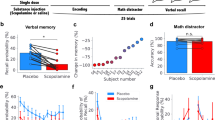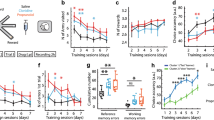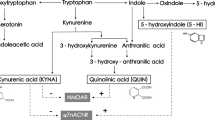Abstract
Antagonists at serotonin type 6 (5-HT6) receptors show activity in models of learning and memory. Although the underlying mechanism(s) are not well understood, these effects may involve an increase in acetylcholine (ACh) levels. The present study sought to characterize the cognitive-enhancing effects of the 5-HT6 antagonist Ro4368554 (3-benzenesulfonyl-7-(4-methyl-piperazin-1-yl)1H-indole) in a rat object recognition task employing a cholinergic (scopolamine pretreatment) and a serotonergic- (tryptophan (TRP) depletion) deficient model, and compared its pattern of action with that of the acetylcholinesterase inhibitor metrifonate. Initial testing in a time-dependent forgetting task employing a 24-h delay between training and testing showed that metrifonate improved object recognition (at 10 and 30 mg/kg, p.o.), whereas Ro4368554 was inactive. Both, Ro4368554 (3 and 10 mg/kg, intraperitoneally (i.p.)) and metrifonate (10 mg/kg, p.o., respectively) reversed memory deficits induced by scopolamine and TRP depletion (10 mg/kg, i.p., and 3 mg/kg, p.o., respectively). In conclusion, although Ro4368554 did not improve a time-related retention deficit, it reversed a cholinergic and a serotonergic memory deficit, suggesting that both mechanisms may be involved in the facilitation of object memory by Ro4368554 and, possibly, other 5-HT6 receptor antagonists.
Similar content being viewed by others
Log in or create a free account to read this content
Gain free access to this article, as well as selected content from this journal and more on nature.com
or
References
Barnes JM, Barnes NM, Cooper SJ (1992). Behavioural pharmacology of 5-HT3 receptor ligands. Neurosci Biobehav Rev 16: 107–113.
Becker RE, Colliver JA, Markwell SJ, Moriearty PL, Unni LK, Vicari S (1998). Effects of metrifonate on cognitive decline in Alzheimer disease: a double-blind, placebo-controlled, 6-month study. Alzheimer Dis Assoc Disord 12: 54–57.
Bentley JC, Bourson A, Boess FG, Fone KC, Marsden CA, Petit N et al (1999). Investigation of stretching behaviour induced by the selective 5-HT6 receptor antagonist, Ro 04-6790, in rats. Br J Pharmacol 126: 1537–1542.
Besheer J, Short KR, Bevins RA (2001). Dopaminergic and cholinergic antagonism in a novel-object detection task with rats. Behav Brain Res 126: 211–217.
Bliss TV, Collingridge GL (1993). A synaptic model of memory: long-term potentiation in the hippocampus. Nature 361: 31–39.
Blokland A (1995). Acetylcholine: a neurotransmitter for learning and memory? Brain Res Rev 21: 285–300.
Blokland A, Hinz V, Schmidt B (1995). Effects of metrifonate and tacrine in the spatial Morris task and modified Irwin test: evaluation of the efficacy/safety profile in rats. Drug Dev Res 36: 166–179.
Bonhaus DW, Martin R, Brothers J, Novakovic S, Lew R, Schwab D et al (2002). Ro4368554, a high affinity, selective, CNS penetrating 5-HT6 receptor antagonist. Soc Neurosci 844: 5.
Bos M, Sleight AJ, Godel T, Martin JR, Riemer C, Stadler H (2001). 5-HT6 receptor antagonists: lead optimisation and biological evaluation of N-aryl and N-heteroaryl 4-amino-benzene sulfonamides. Eur J Med Chem 36: 165–178.
Bourson A, Boess FG, Bos M, Sleight AJ (1998). Involvement of 5-HT6 receptors in nigro-striatal function in rodents. Br J Pharmacol 125: 1562–1566.
Bromidge SM, Brown AM, Clarke SE, Dodgson K, Gager T, Grassam HL et al (1999). 5-Chloro-N-(4-methoxy-3-piperazin-1-yl-phenyl)-3-methyl-2-benzothiophenesulfon- amide (SB-271046): a potent, selective, and orally bioavailable 5-HT6 receptor antagonist. J Med Chem 42: 202–205.
Buhot MC, Martin S, Segu L (2000). Role of serotonin in memory impairment. Ann Med 32: 210–221.
Cummings JL, Cyrus PA, Bieber F, Mas J, Orazem J, Gulanski B (1998). Metrifonate treatment of the cognitive deficits of Alzheimer's disease. Metrifonate Study Group. Neurology 50: 1214–1221.
Dachir S, Schmidt B, Levy A (1997). Effects of metrifonate on radial arm maze acquisition in middle-aged rats. Brain Res 777: 251–254.
Dawson LA, Nguyen HQ, Li P (2000). In vivo effects of the 5-HT6 antagonist SB-271046 on striatal and frontal cortex extracellular concentrations of noradrenaline, dopamine, 5-HT, glutamate and aspartate. Br J Pharmacol 130: 23–26.
Dawson LA, Nguyen HQ, Li P (2001). The 5-HT6 receptor antagonist SB-271046 selectively enhances excitatory neurotransmission in the rat frontal cortex and hippocampus. Neuropsychopharmacology 25: 662–668.
Dawson LA, Nguyen HQ, Li P (2003). Potentiation of amphetamine-induced changes in dopamine and 5-HT by a 5-HT6 receptor antagonist. Brain Res Bull 59: 513–521.
Dodart JC, Mathis C, Ungerer A (1997). Scopolamine-induced deficits in a two-trial object recognition task in mice. Neuroreport 8: 1173–1178.
Ennaceur A, Delacour J (1988). A new one-trial test for neurobiological studies of memory in rats. 1: Behavioral data. Behav Brain Res 31: 47–59.
Ennaceur A, Meliani K (1992). Effects of physostigmine and scopolamine on rats' performances in object-recognition and radial-maze tests. Psychopharmacology (Berl) 109: 321–330.
Foley AG, Murphy KJ, Hirst WD, Gallagher HC, Hagan JJ, Upton N et al (2004). The 5-HT6 receptor antagonist SB-271046 reverses scopolamine-disrupted consolidation of a passive avoidance task and ameliorates spatial task deficits in aged rats. Neuropsychopharmacology 29: 93–100.
Gerard C, Martres MP, Lefevre K, Miquel MC, Verge D, Lanfumey L et al (1997). Immuno-localization of serotonin 5-HT6 receptor-like material in the rat central nervous system. Brain Res 746: 207–219.
Gillet G, Ammor S, Fillion G (1985). Serotonin inhibits acetylcholine release from rat striatum slices: evidence for a presynaptic receptor-mediated effect. J Neurochem 45: 1687–1691.
Golightly KL, Lloyd JA, Hobson JE, Gallagher P, Mercer G, Young AH (2001). Acute tryptophan depletion in schizophrenia. Psychol Med 31: 75–84.
Itoh A, Nitta A, Katono Y, Usui M, Naruhashi K, Iida R et al (1997). Effects of metrifonate on memory impairment and cholinergic dysfunction in rats. Eur J Pharmacol 322: 11–19.
King MV, Sleight AJ, Woolley ML, Topham IA, Marsden CA, Fone KC (2004). 5-HT(6) receptor antagonists reverse delay-dependent deficits in novel object discrimination by enhancing consolidation—an effect sensitive to NMDA receptor antagonism. Neuropharmacology 47: 195–204.
Lacroix LP, Dawson LA, Hagan JJ, Heidbreder CA (2004). 5-HT6 receptor antagonist SB-271046 enhances extracellular levels of monoamines in the rat medial prefrontal cortex. Synapse 51: 158–164.
Leonard CS, Llinas R (1994). Serotonergic and cholinergic inhibition of mesopontine cholinergic neurons controlling REM sleep: an in vitro electrophysiological study. Neuroscience 59: 309–330.
Lieben CK, Blokland A, Westerink B, Deutz NE (2004a). Acute tryptophan and serotonin depletion using an optimized tryptophan-free protein–carbohydrate mixture in the adult rat. Neurochem Int 44: 9–16.
Lieben CK, van Oorsouw K, Deutz NE, Blokland A (2004b). Acute tryptophan depletion induced by a gelatin-based mixture impairs object memory but not affective behavior and spatial learning in the rat. Behav Brain Res 151: 53–64.
Lindner MD, Hodges Jr DB, Hogan JB, Orie AF, Corsa JA, Barten DM et al (2003). An assessment of the effects of serotonin 6 (5-HT6) receptor antagonists in rodent models of learning. J Pharmacol Exp Ther 307: 682–691.
Lynch MA (2004). Long-term potentiation and memory. Physiol Rev 84: 87–136.
Maura G, Fedele E, Raiteri M (1989). Acetylcholine release from rat hippocampal slices is modulated by 5-hydroxytryptamine. Eur J Pharmacol 165: 173–179.
McEntee WJ, Crook TH (1991). Serotonin, memory, and the aging brain. Psychopharmacology 103: 143–149.
Meneses A (1999). 5-HT system and cognition. Neurosci Biobehav Rev 23: 1111–1125.
Meneses A (2001). Role of 5-HT6 receptors in memory formation. Drug News Perspect 14: 396–400.
Myhrer T (2003). Neurotransmitter systems involved in learning and memory in the rat: a meta-analysis based on studies of four behavioral tasks. Brain Res Rev 41: 268–287.
Park SB, Coull JT, McShane RH, Young AH, Sahakian BJ, Robbins TW et al (1994). Tryptophan depletion in normal volunteers produces selective impairments in learning and memory. Neuropharmacology 33: 575–588.
Pitsikas N, Rigamonti AE, Cella SG, Locatelli V, Sala M, Muller EE (2001). Effects of molsidomine on scopolamine-induced amnesia and hypermotility in the rat. Eur J Pharmacol 426: 193–200.
Porter RJ, Lunn BS, O'Brien JT (2003). Effects of acute tryptophan depletion on cognitive function in Alzheimer's disease and in the healthy elderly. Psychol Med 33: 41–49.
Prickaerts J, Honig W, Schmidt BH, Blokland A (1999). Metrifonate improves working but not reference memory performance in a spatial cone field task. Eur J Pharmacol 380: 61–65.
Prickaerts J, Şık A, van der Staay FJ, de Vente J, Blokland A (2005). Dissociable effects of acetylcholinesterase inhibitors and phosphodiesterase type 5 inhibitors on object recognition memory: acquisition versus consolidation. Psychopharmacology (Berl) 177: 381–390.
Richards P, Johnson M, Ray D, Walker C (1999). Novel protein targets for organophosphorus compounds. Chem Biol Interact 119–120: 503–511.
Richards PG, Johnson MK, Ray DE (2000). Identification of acylpeptide hydrolase as a sensitive site for reaction with organophosphorus compounds and a potential target for cognitive enhancing drugs. Mol Pharmacol 58: 577–583.
Riedel WJ, Klaassen T, Deutz NE, van Someren A, van Praag HM (1999). Tryptophan depletion in normal volunteers produces selective impairment in memory consolidation. Psychopharmacology (Berl) 141: 362–369.
Riedel WJ, Klaassen T, Schmitt JA (2002). Tryptophan, mood, and cognitive function. Brain Behav Immun 16: 581–589.
Riekkinen Jr P, Schmidt BH, Stefanski R, Kuitunen J, Riekkinen M (1996). Metrifonate improves spatial navigation and avoidance behavior in scopolamine-treated, medial septum-lesioned and aged rats. Eur J Pharmacol 309: 121–130.
Riemer C, Borroni E, Levet-Trafit B, Martin JR, Poli S, Porter RH et al (2003). Influence of the 5-HT6 receptor on acetylcholine release in the cortex: pharmacological characterization of 4-(2-bromo-6-pyrrolidin-1-ylpyridine-4-sulfonyl)phenylamine, a potent and selective 5-HT6 receptor antagonist. J Med Chem 46: 1273–1276.
Ringman JM, Cummings JL (1999). Metrifonate: update on a new antidementia agent. J Clin Psychiatry 60: 776–782.
Robbins TW (1998). Homology in behavioural pharmacology: an approach to animal models of human cognition. Behav Pharmacol 9: 509–519.
Roberts JC, Reavill C, East SZ, Harrison PJ, Patel S, Routledge C et al (2002). The distribution of 5-HT6 receptors in rat brain: an autoradiographic binding study using the radiolabelled 5-HT6 receptor antagonist [125I]SB-258585. Brain Res 934: 49–57.
Robinson SE (1983). Effect of specific serotonergic lesions on cholinergic neurons in the hippocampus, cortex and striatum. Life Sci 32: 345–353.
Rogers DC, Hagan JJ (2001). 5-HT6 receptor antagonists enhance retention of a water maze task in the rat. Psychopharmacology (Berl) 158: 114–119.
Ruat M, Traiffort E, Arrang JM, Tardivel-Lacombe J, Diaz J, Leurs R et al (1993). A novel rat serotonin (5-HT6) receptor: molecular cloning, localization and stimulation of cAMP accumulation. Biochem Biophys Res Commun 193: 268–276.
Rubinsztein JS, Rogers RD, Riedel WJ, Mehta MA, Robbins TW, Sahakian BJ (2001). Acute dietary tryptophan depletion impairs maintenance of ‘affective set’ and delayed visual recognition in healthy volunteers. Psychopharmacology (Berl) 154: 319–326.
Russell MG, Dias R (2002). Memories are made of this (perhaps): a review of serotonin 5-HT6 receptor ligands and their biological functions. Curr Top Med Chem 2: 643–654.
Sarter M, Bruno JP, Givens B (2003). Attentional functions of cortical cholinergic inputs: what does it mean for learning and memory? Neurobiol Learn Mem 80: 245–256.
Scali C, Giovannini MG, Bartolini L, Prosperi C, Hinz V, Schmidt B et al (1997). Effect of metrifonate on extracellular brain acetylcholine and object recognition in aged rats. Eur J Pharmacol 325: 173–180.
Shirazi-Southall S, Rodriguez DE, Nomikos GG (2002). Effects of typical and atypical antipsychotics and receptor selective compounds on acetylcholine efflux in the hippocampus of the rat. Neuropsychopharmacology 26: 583–594.
Şık A, van Nieuwenhuyzen P, Prickaerts J, Blokland A (2003). Performance of different mouse strains in an object recognition task. Behav Brain Res 147: 49–54.
Sleight AJ, Boess FG, Bos M, Bourson A (1998). The putative 5-HT6 receptor: localization and function. Ann NY Acad Sci 861: 91–96.
Sobczak S, Riedel WJ, Booij I, Aan Het Rot M, Deutz NE, Honig A (2002). Cognition following acute tryptophan depletion: difference between first-degree relatives of bipolar disorder patients and matched healthy control volunteers. Psychol Med 32: 503–515.
Steckler T, Sahgal A (1995). The role of serotonergic–cholinergic interactions in the mediation of cognitive behaviour. Behav Brain Res 67: 165–199.
Szczepanski K, Vivian JA, Dorsch K, Blokland A, Hedley L, Lieben C et al (2002). Procognitive effects of the 5-HT6 receptor antagonist Ro4368554. Soc Neurosci 290: 20.
van der Staay FJ, Hinz VC, Schmidt BH (1996a). Effects of metrifonate on escape and avoidance learning in young and aged rats. Behav Pharmacol 7: 56–64.
van der Staay FJ, Hinz VC, Schmidt BH (1996b). Effects of metrifonate, its transformation product dichlorvos, and other organophosphorus and reference cholinesterase inhibitors on Morris water escape behavior in young-adult rats. J Pharmacol Exp Ther 278: 697–708.
Woolley ML, Bentley JC, Sleight AJ, Marsden CA, Fone KC (2001). A role for 5-HT6 receptors in retention of spatial learning in the Morris water maze. Neuropharmacology 41: 210–219.
Woolley ML, Marsden CA, Sleight AJ, Fone KC (2003). Reversal of a cholinergic-induced deficit in a rodent model of recognition memory by the selective 5-HT6 receptor antagonist, Ro 04-6790. Psychopharmacology (Berl) 170: 358–367.
Woolley ML, Marsden CA, Fone KC (2004). 5-HT6 receptors. Curr Drug Targets: CNS Neurobiol Disord 3: 59–79.
Acknowledgements
We gratefully acknowledge the helpful suggestions of Dr Doug Bonhaus and Dr Marie Woolley.
Author information
Authors and Affiliations
Corresponding author
Rights and permissions
About this article
Cite this article
Lieben, C., Blokland, A., Şık, A. et al. The Selective 5-HT6 Receptor Antagonist Ro4368554 Restores Memory Performance in Cholinergic and Serotonergic Models of Memory Deficiency in the Rat. Neuropsychopharmacol 30, 2169–2179 (2005). https://doi.org/10.1038/sj.npp.1300777
Received:
Revised:
Accepted:
Published:
Issue date:
DOI: https://doi.org/10.1038/sj.npp.1300777
Keywords
This article is cited by
-
5-HT6 receptor agonist and antagonist modulates ICV-STZ-induced memory impairment in rats
Psychopharmacology (2018)
-
Biperiden selectively induces memory impairment in healthy volunteers: no interaction with citalopram
Psychopharmacology (2015)
-
Spontaneous object recognition and its relevance to schizophrenia: a review of findings from pharmacological, genetic, lesion and developmental rodent models
Psychopharmacology (2012)
-
5-HT6 receptor blockade differentially affects scopolamine-induced deficits of working memory, recognition memory and aversive learning in mice
Psychopharmacology (2012)
-
The effects of PRX-07034, a novel 5-HT6 antagonist, on cognitive flexibility and working memory in rats
Psychopharmacology (2012)



